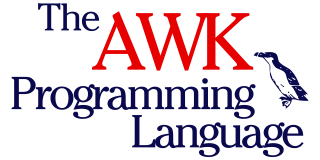
AWK is a domain-specific language designed for text processing and typically used as a data extraction and reporting tool. Like sed and grep, it is a filter, and is a standard feature of most Unix-like operating systems.
Icon is a very high-level programming language based on the concept of "goal-directed execution" in which code returns a "success" along with valid values, or a "failure", indicating that there is no valid data to return. The success and failure of a given block of code is used to direct further processing, whereas conventional languages would typically use boolean logic written by the programmer to achieve the same ends. Because the logic for basic control structures is often implicit in Icon, common tasks can be completed with less explicit code.
A web service (WS) is either:
In computer software, business logic or domain logic is the part of the program that encodes the real-world business rules that determine how data can be created, stored, and changed. It is contrasted with the remainder of the software that might be concerned with lower-level details of managing a database or displaying the user interface, system infrastructure, or generally connecting various parts of the program.
In software engineering, the mediator pattern defines an object that encapsulates how a set of objects interact. This pattern is considered to be a behavioral pattern due to the way it can alter the program's running behavior.
In software design and engineering, the observer pattern is a software design pattern in which an object, named the subject, maintains a list of its dependents, called observers, and notifies them automatically of any state changes, usually by calling one of their methods.
ABAP is a high-level programming language created by the German software company SAP SE. It is currently positioned, alongside Java, as the language for programming the SAP NetWeaver Application Server, which is part of the SAP NetWeaver platform for building business applications.
In software engineering, the terms frontend and backend refer to the separation of concerns between the presentation layer (frontend), and the data access layer (backend) of a piece of software, or the physical infrastructure or hardware. In the client–server model, the client is usually considered the frontend and the server is usually considered the backend, even when some presentation work is actually done on the server itself.
In computer programming, glob patterns specify sets of filenames with wildcard characters. For example, the Unix Bash shell command mv *.txttextfiles/ moves all files with names ending in .txt from the current directory to the directory textfiles. Here, * is a wildcard and *.txt is a glob pattern. The wildcard * stands for "any string of any length including empty, but excluding the path separator characters ".
This is an alphabetical list of articles pertaining specifically to software engineering.
Event-driven architecture (EDA) is a software architecture paradigm concerning the production and detection of events.
The anemic domain model is described as a programming anti-pattern where the domain objects contain little or no business logic like validations, calculations, rules, and so forth. The business logic is thus baked into the architecture of the program itself, making refactoring and maintenance more difficult and time-consuming.
Clean URLs are web addresses or Uniform Resource Locator (URLs) intended to improve the usability and accessibility of a website, web application, or web service by being immediately and intuitively meaningful to non-expert users. Such URL schemes tend to reflect the conceptual structure of a collection of information and decouple the user interface from a server's internal representation of information. Other reasons for using clean URLs include search engine optimization (SEO), conforming to the representational state transfer (REST) style of software architecture, and ensuring that individual web resources remain consistently at the same URL. This makes the World Wide Web a more stable and useful system, and allows more durable and reliable bookmarking of web resources.

fpGUI, the Free Pascal GUI toolkit, is a cross-platform graphical user interface toolkit developed by Graeme Geldenhuys. fpGUI is open source and free software, licensed under a Modified LGPL license. The toolkit has been implemented using the Free Pascal compiler, meaning it is written in the Object Pascal language.
A file format is a standard way that information is encoded for storage in a computer file. It specifies how bits are used to encode information in a digital storage medium. File formats may be either proprietary or free.
In computer programming, a magic string is an input that a programmer believes will never come externally and which activates otherwise hidden functionality. A user of this program would likely provide input that gives an expected response in most situations. However, if the user does in fact innocently provide the pre-defined input, invoking the internal functionality, the program response is often quite unexpected to the user.

A command-line interface (CLI) is a means of interacting with a computer program by inputting lines of text called command-lines. Command-line interfaces emerged in the mid-1960s, on computer terminals, as an interactive and more user-friendly alternative to the non-interactive interface available with punched cards.
In software engineering, the module pattern is a design pattern used to implement the concept of software modules, defined by modular programming, in a programming language with incomplete direct support for the concept.
LibSBML is an open-source software library that provides an application programming interface (API) for the SBML format. The libSBML library can be embedded in a software application or used in a web servlet as part of the application or servlet's implementation of support for reading, writing, and manipulating SBML documents and data streams. The core of libSBML is written in ISO standard C++; the library provides API for many programming languages via interfaces generated with the help of SWIG.
Smart Pascal is a dialect of the Object Pascal programming language that is derived from Delphi Web Script, but is adapted for Smart Mobile Studio, a commercial development suite that generates JavaScript rather than machine code.


